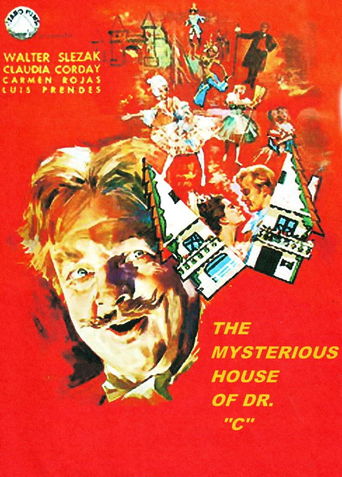

Dr. Coppelius (1968)
Film based on the ballet 'Coppelia.' This version is completely silent, not containing the songs/narration, or animation of the later reworking, Mysterious House of Dr. C.
Watch Trailer
Cast
Reviews
Purely Joyful Movie!
Fantastic!
The story, direction, characters, and writing/dialogue is akin to taking a tranquilizer shot to the neck, but everything else was so well done.
An old-fashioned movie made with new-fashioned finesse.
I happened on this movie yesterday afternoon on Turner Classic Movies, and I found it charming. If you're used to ballets you understand that they often use fairy tale plots as an excuse for lots of dancing so the stories are in no way intended to be realistic but are used simply as an excuse for dance. Despite the criticisms of lighting and settings, the quality of the dancing and the delightful characterizations of Slezak and the dancer playing his daughter make the movie worth watching. I would love to see it be made available as a DVD so that I could use it to introduce my grand daughters to a ballet with a plot that does not contain frightening scenes or deaths of main characters.
There are two versions of this rare film: "Dr. Coppelius" (1968) and "The Mysterious House of Dr. C" (1976).Here is my review for "Dr. Coppelius" (1968). This ballet film is very rare. I hope a DVD of "Dr. Coppelius" (1968) will be released, because this film deserves more recognition.This is a charming, uplifting film, with ballet, Delibes music, and pantomime only. It combines wonderful dancing, music, comedy, romance, and magic, all in brilliant colors. The costumes and sets are lavish.(Some lite spoilers here.) This is the basic storyline of "Dr. Coppelius" (1968). The film is set in a European village during the 1800s. Dr. Coppelius is an eccentric inventor and alchemist, who creates lifelike mechanical dolls (automatons) in his spooky house on a rocky hill. Franz, a village lad, becomes infatuated with a beautiful automaton named Coppelia, who wears a lovely pink Victorian dress. Franz' girlfriend Swanhilda gets jealous, and sneaks into Dr. Coppelius' house, where she has many adventures. The original "Dr. Coppelius" (1968) film has numerous superb ballets. There is a spectacular large-scale ballet in the village square, with dozens of ballet dancers wearing red folk costumes, illuminated with vivid red and pink light. The 1968 film has a magical, fairy tale atmosphere. I give the 1968 film ten stars. Here is some information about "The Mysterious House of Dr. C." The 1968 film was drastically edited in 1976, adding a voice-over narration, cartoon animation, and songs. Several ballets were cut short. It was renamed "The Mysterious House of Dr. C." The voice-over narration, cartoons and songs are distracting, and interrupt the flow of the film. I much prefer the original "Dr. Coppelius" (1968) movie, which is a true classic ballet film.
Spoiler-lite. In 1966, the classic ballet "Coppélia" got a big-screen makeover. Familiar Austrian actor Walter Slezak ("Lifeboat") starred as title character Dr. Coppelius, a lovably diabolical inventor who delighted in terrifying the townspeople to keep them from learning his secret: the guests frequently seen in his home were actually life-sized wind-up toys that he'd built. But when a young man named Franz (Caj Selling) flirts with one of the good doctor's creations from afar, his girlfriend Swanhilda (Claudia Corday) and her pals break into the doctor's foreboding mansion and discover the truth. And then it gets really weird...Featuring lavish sets, costumes, camera-work and choreography, the movie is wonderfully off-kilter... but admittedly, as a whole it doesn't entirely gel. Slezak and Corday are thoroughly appealing and clearly relished their roles. Unfortunately the Franz character has little to do but prance around seeming overtly gay despite his advances towards two women. A secondary love story for Dr. C. which was devised especially for the film feels a bit forced, but Eileen Elliott is delightful as his wannabe girlfriend. And perhaps it's because I'm not a ballet fan, but it seems like there's an inordinate amount of dancing -- there's several overlong sequences featuring the townspeople kicking up their heels which have virtually nothing to with the story and don't further the plot. Though I suppose that was a trend at the time ("Oliver!," "Bedknobs and Broomsticks," etc.). Still, the movie is engaging -- clearly it was a labor of love for everyone involved -- and anyone who likes the production design in old time horror movies should get a kick out of Dr. C's mysterious house.The movie sprang to life from an experimental mime/ballet improv workshop in Florida sometime in the mid-'60s. Husband and wife team Ted and Jo Anna Kneeland helmed the film (he directed, she choreographed), they got an investor from Florida, assembled an international cast and filmed in Madrid. When it finally got a global release in 1968 as "Dr.?? Coppelius!!!," the movie was met with glowing reviews on both sides of the ocean. Unfortunately, soon after the premiere the distributor filed for bankruptcy and the film got ensnared in a legal mess. Once the creators re-established their rights, the movie was reworked and re-released in 1976 as "The Mysterious House of Dr. C.," but that version -- which included overdubbed songs, dialogue, narration and two animated dream sequences -- was altogether ignored. There's been a lot of criticism of the '76 version, but it's not entirely deserved. The original filmmakers added words to make their story easier to follow, it's not as if it was destroyed by clueless studio executives (according to the credits they even brought back Veronica Kusmin to voice her character's animated replacement). The '68 cut was eventually released on VHS in the USA and UK, but it languished on video shelves and is now long out of print. Sad story, but now that Turner Classic Movies has unearthed both the original and '70s edits of the movie, perhaps the film will finally find the audience that it so greatly deserves.Odd post-script. It's a total fluke that I discovered this, but Jerry Goldsmith's score for the first "Gremlins" syncs up with the movie in a really freaky "Dark Side of the Rainbow" sort of way.
Stilted Spanish-made adaptation of the ballet libretto "Coppelia", busy on its feet and yet with little personality behind or in front of the camera. In a small village, the curious Dr. Coppelius keeps the townspeople at bay by setting off innocuous explosions; what he's really hiding is a fantastic workshop filled with life-size dolls of his own creation. When intrepid young sweethearts break into the doctor's house, they discover his secret, with the girl impersonating the doctor's latest invention. "Dr. Coppelius" was apparently a labor of love for Ted and Jo Anna Kneeland--he directed, she choreographed the dancing, and they both had a hand in the writing; yet, despite an imaginative art direction and production design, the film seems rather unwieldy, most especially during the dance sequences which are poorly-staged. Barely circulated in the late-1960s, the Kneelands tried for another release in 1976 (using the title "The Mysterious House of Dr. C."), adding horrendous narration and character voice-overs, two animated dream sequences, and songs to explain nearly every bit of human interaction. It's certainly a curio--and a good-looking one, with changing light cues in garish golds, blood reds, mad pinks, and frosty blues--yet the effort is best described as a misfire. ** from ****

